Bull or bear, long-term stock market investors win
Conserve some cash, but don't be afraid to make staggered investments in blue-chip stocks in current times of high uncertainty and market volatility
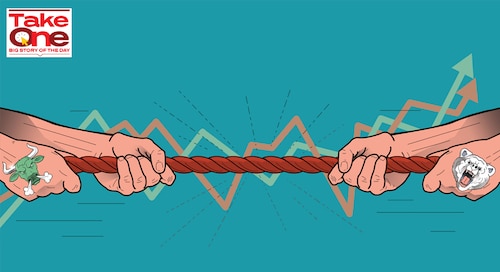

Rock and roll of the bulls, or jazz of the bears, seemingly, stock investors are unwilling to leave the party yet. The phenomenal equity returns in the summer of 2020 and 2021 have given investors a strong reason to keep the spirit up, as they try hard to match steps with the beats of this highly volatile market.
However, there are signs of fatigue setting in as risks increase and uncertainty takes a toll on outlook for returns.
Central banks have been preparing to turn off the liquidity tap as they wrestle inflation. After nearly four years, the US Federal Reserve hiked interest rates by 25 basis points on March 16, as it expects inflation to remain elevated above 4 percent. The US Fed has indicated series of rate hikes to bring the benchmark rate to 2.8 percent (see chart).
“I think the US Fed rate hike has pretty much been discounted," says Hiren Ved, founder, director, and CIO at Alchemy Capital Management.
Neelesh Surana, CIO-equity, Mirae Asset Investment Managers, says the stability of crude prices is more important than the pace of interest rate increase in the US, which has been anticipated for some time. “It’s the end-of-an-era of low interest rate and under the new regime, global equities would behave differently. Pockets of froth created due to low interest rates would normalise," he adds.
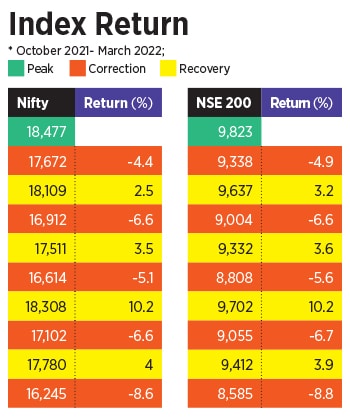
The raging war between Russia and Ukraine has set to motion a series of unfavourable events for the markets. Of these, the biggest sore point that has subsequently upset growth estimates is the rise in the price of crude oil.
“The recent correction is primarily led by the oil and commodities shock caused by the ongoing Russia-Ukraine conflict, which will have negative impact on India’s current account, inflation and consumer demand. The impact will be a function of where oil settles as current levels are high," Surana adds.
Oil prices surged from $78 per barrel in January to $139—the highest in 14 years—in the second week of March. However, the rise in coronavirus cases in China, the world’s largest oil importer, coupled with a potential nuclear deal with Iran, has helped cool the price of crude oil to around $100. But, so far, there is little clarity at what level oil prices will stabilise this year.
Inflation is no longer seen as a transient concern, and fund managers fear earnings may crack due to high input costs and low demand over the next few quarters. The widening negative gap between bond yields and earnings yields has put corporate earnings and stock valuations in a grim spot.

“FY23 earnings will be erratic owing to the ongoing crude and commodities shock. However, the consensus numbers for FY24 are intact although the mix has changed marginally. We would see some downgrades in consumer-facing businesses, while exporters will benefit from currency depreciation," says Surana.
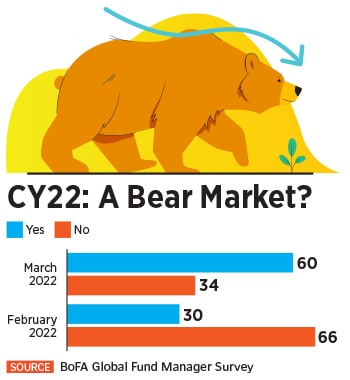 Furthermore, it remains to be seen if the Reserve Bank of India (RBI) will hike rates in the next couple of months since retail inflation once again breached its comfort level of 6 percent in February.
Furthermore, it remains to be seen if the Reserve Bank of India (RBI) will hike rates in the next couple of months since retail inflation once again breached its comfort level of 6 percent in February.
In this backdrop, one of the most frequently asked questions is, how far are the markets from the bottom?
“If the worst of crude oil inflation caused by the Russia-Ukraine war is over, we believe that the markets have bottomed-out. However, there could be volatility in the next couple of quarters as earnings will be challenging for many businesses since the ability to pass on [higher costs due to] sudden inflation is limited," says Surana.
“We are waiting for some calmness to decide which way the market will move. We want to wait for Q4 numbers and management commentary to understand which companies will be the leaders going forward," says Jinesh Gopani, head- equity, Axis MF.
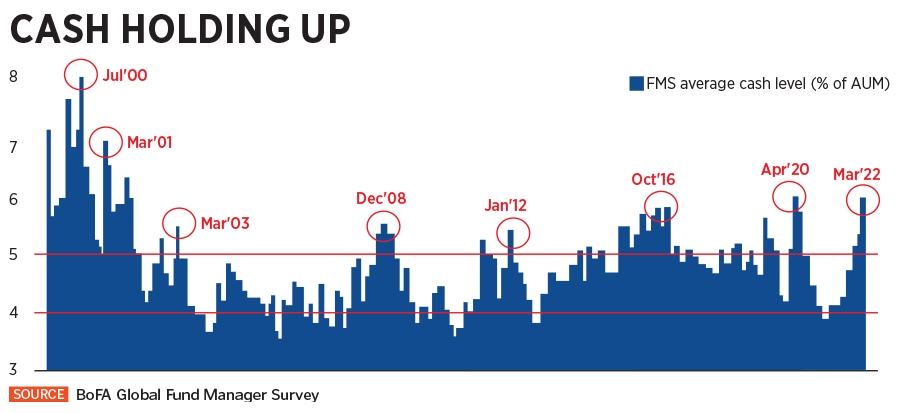
Importantly, there isn’t a ‘one-size-fits-all’ approach that can be universally applied by investors. Age, risk appetite, financial goals, corpus and surplus funds are some important areas to consider for equity investments.
 In times of such volatility, Surana advises investors to consider staggered investments in equities through SIPs or STPs. “Investors who are underweight equities should buy the dip and go equal weight. We believe that India has strong and sustainable drivers for secular growth, and thus our view on equities is constructive. In this context, we would advise investors not to time the market and invest in equities in a disciplined way for the long term," he adds.
In times of such volatility, Surana advises investors to consider staggered investments in equities through SIPs or STPs. “Investors who are underweight equities should buy the dip and go equal weight. We believe that India has strong and sustainable drivers for secular growth, and thus our view on equities is constructive. In this context, we would advise investors not to time the market and invest in equities in a disciplined way for the long term," he adds.
“It is a dynamic situation and I think investors should be careful. If things go out of hand… for example, if the war drags on for too long or oil price climbs to $150 levels, then it is a very difficult situation [to be in]. We don"t know and we cannot predict. So, invest systematically, slowly and steadily. Conserve some cash, but don"t be totally afraid to invest," suggests Ved.

“There is no point being adventurous because frankly no one knows what will happen given the high volatility. But sitting on cash doesn"t help beyond a point. The idea is to meet companies and try to assess whether the company will be able to deliver returns in difficult periods. If that is the case then, based on valuation, we will buy or add the stock to our portfolio," says Gopani.
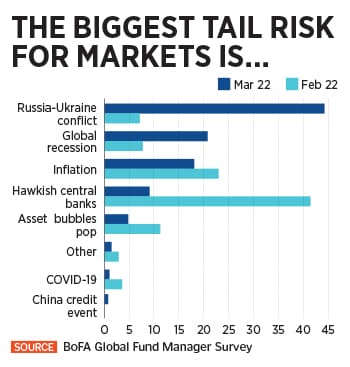 The market momentum will closely hinge on the trajectory of oil prices in the coming months. “I don"t see more than a 10 percent downside on the markets from the current levels unless oil prices increase to $200 a barrel—in which case all bets are off. As things stand today, it would be fair to say that our upside is capped at 17,500-18,000 at least for the next three to four quarters. The situation is very dynamic and it is very difficult to say what will happen for the full year," points out Ved.
The market momentum will closely hinge on the trajectory of oil prices in the coming months. “I don"t see more than a 10 percent downside on the markets from the current levels unless oil prices increase to $200 a barrel—in which case all bets are off. As things stand today, it would be fair to say that our upside is capped at 17,500-18,000 at least for the next three to four quarters. The situation is very dynamic and it is very difficult to say what will happen for the full year," points out Ved.
Market experts caution investors must not set the extraordinary stock returns of the past two years as a benchmark. “One should not extrapolate they will repeat the returns seen in 2020 because that was an extraordinary time. This is a very hazardous kind of market to do any kind of trading. You should only invest with a long-term horizon in quality companies," says Ved.
Despite the uncertainty, buying the dip may be a good option for long-term investors who have a high-risk appetite. “We are telling investors to use this uncertainty and the fact that the markets are now correcting to actually slowly build stock positions if one has the ability to gradually invest between now and June to take advantage of this soft period," adds Ved.

The markets have corrected around 7 percent since it peaked last October. There have been five correction cycles followed by four recovery cycles (see chart). New investors, who increased their stake in stocks in October last year, after their first experience of supernormal returns in 2020-21, are in the lurch. The lack of experience and expertise in equity markets has left many high and dry.
“Equities are a long-term asset class, and the best way to review is to look at five-year rolling returns. It’s impossible to predict near-term returns, and investors who have invested in the last one year will need handholding to learn to remain patient," asserts Surana.

Interestingly, a global survey of fund managers by Bank of America finds out that 60 percent investors expect a bear market in the current calendar year, and the level of cash holding has risen to 5.9 percent from 5.3 percent earlier as investors turn more cautious (see charts).
There are three critical factors that will keep markets on the edge: Oil, inflation and currency movement (see chart).

“If oil is above $100, then clearly India’s macros will become weaker. It will be a challenging task for the government and the RBI on how to manage inflation and keep the growth momentum going," says Gopani.
India is vulnerable to oil price fluctuations as it can derail the growth momentum. The cascading impact of higher commodity prices can pull down the GDP to 7.5 percent and widen the current account deficit to 3 percent. As a result, this can amplify fiscal concerns and limit the ability of the government to boost capital expenditure. Besides, higher input costs will squeeze corporate margins and dent profits of India Inc.
“There is a downside risk to earnings and therefore my view is that markets will be range-bound. Markets have been assuming that earnings will grow at 17-18 percent, but due to inflation earnings, may grow just 8-10 percent," says Ved.
Surana believes earnings will be driven by bottom-up revival in sectors like financial services, IT, telecom and metals despite the recent developments. “Internal earnings divergence would be high with upgrades for exporters and commodity companies, and consumer sectors will see downgrade while it will be neutral for financials. Overall, markets are now trading at about 15-16x FY24 EPS, which we believe is reasonable given that post the ongoing headwinds, the long-term growth drivers are intact," he adds.
Whether calendar year 2022 is a bull market or a bear market, market veterans are confident about the long-term growth story of India. As the economy gallops, the stock market can hardly lag behind. The key to compounding wealth is to own stocks of companies that show promising signs of high sustainable returns in the coming decade.
In this context, most fund managers advise investors to remain invested in blue-chip companies, with a portfolio allocation of 70-75 percent towards large-caps.
“Generally, large, well-managed companies have better ability to withstand ongoing shocks. Secondly, in India, the long-term growth potential is intact for large caps. In addition, the ongoing consolidation across businesses is in favour of strong and large companies. Lastly, a large part of the recent FII (foreign institutional investor) selling has been skewed in large-caps and this is a technical factor which is leading to quotational rather than permanent loss," says Surana.

Some pockets, such as the pharma, IT and manufacturing sectors, of the market have solely corrected due to the change in overall market sentiment, even though the underlying business remains relatively strong, says Surana. “Overall, we believe that across sectors, we should look at strong companies as they are better positioned to weather the oil crisis," he adds.
Gopani prefers a stock-specific strategy that cuts across sectors and market caps. “Buy leaders in the large cap space, and buy probable leaders in the small and mid-cap space. We look for the ability of management to showcase something innovative, grow higher-than-the-market average, and deliver higher RoE (return on equity) and cash flows, with high scrutiny on corporate governance," he says.
Companies which buck the trend by reporting strong earnings in relation to peers despite the inflationary storm, will be seen as good additions to investment portfolios. “We feel a broad-based rally will be over and it will be more to do with stock-specific activity where companies are able to turnaround or retain strong pricing power and business model even during difficult periods of inflation," adds Gopani.
Many fund managers do not rule out a further downside of 10 percent from current levels until the markets bottom out. The challenge for investors is to keep greed and fear in check as they navigate the next few months of shaky global macros and its rub-off-effect on the stock markets. “In the longer term, I have no doubt that we are in a bull market, but till June, we have a problem on our hands. Post June, it depends on how the situation pans out. But in the next two quarters, the market is not crossing the previous high for sure," says Ved.
First Published: Mar 17, 2022, 14:04
Subscribe Now